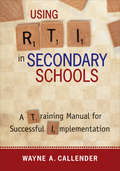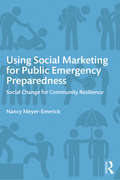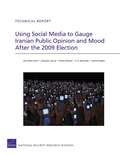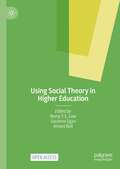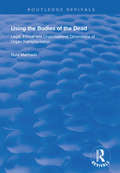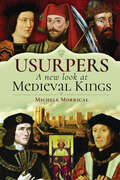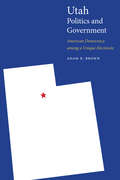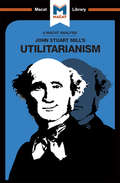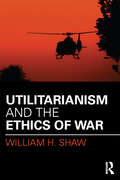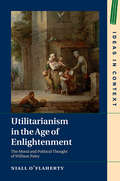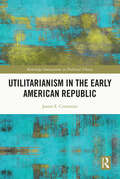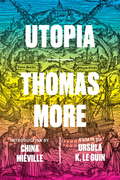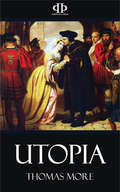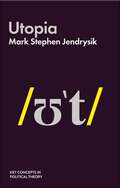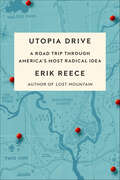- Table View
- List View
Using RTI in Secondary Schools: A Training Manual for Successful Implementation
by Wayne A. CallenderEffective use of RTI: your road map for reaching every struggling secondary student! No educator wants to see their secondary students fail classes, drop out, and risk a lifetime of reduced opportunity. Response to Intervention (RTI) allows educators to identify at-risk students and help them before problems snowball. Developed specifically for secondary schools, this comprehensive manual offers a step-by-step RTI program, including helpful templates and tools. Readers will learn how to: Combine two leading, research-based RTI approaches (Standard Protocol and Problem-Solving) to make the most of existing resources Develop and manage a universal screening process that identifies at-risk students Create a comprehensive student intervention plan (iPlan) for each student, with a focus on skill-building Understand and implement curriculum-based measurement and other progress monitoring techniques Adapt RTI to Special Education programs Learn how to plan, deliver, and maintain a successful RTI program! "I highly recommend this book to all stakeholders who want to be proactive in changing the school experience for students who need support. Classroom teachers, especially, will appreciate the checklists, tips, and strategies." —A. L. Hough-Everage, Professor of Education Brandman University
Using RTI in Secondary Schools: A Training Manual for Successful Implementation
by Wayne A. CallenderEffective use of RTI: your road map for reaching every struggling secondary student! No educator wants to see their secondary students fail classes, drop out, and risk a lifetime of reduced opportunity. Response to Intervention (RTI) allows educators to identify at-risk students and help them before problems snowball. Developed specifically for secondary schools, this comprehensive manual offers a step-by-step RTI program, including helpful templates and tools. Readers will learn how to: Combine two leading, research-based RTI approaches (Standard Protocol and Problem-Solving) to make the most of existing resources Develop and manage a universal screening process that identifies at-risk students Create a comprehensive student intervention plan (iPlan) for each student, with a focus on skill-building Understand and implement curriculum-based measurement and other progress monitoring techniques Adapt RTI to Special Education programs Learn how to plan, deliver, and maintain a successful RTI program! "I highly recommend this book to all stakeholders who want to be proactive in changing the school experience for students who need support. Classroom teachers, especially, will appreciate the checklists, tips, and strategies." —A. L. Hough-Everage, Professor of Education Brandman University
Using Research Evidence in Education
by Alan J. Daly Kara S. FinniganThis book includes a set of rigorous and accessible studies on the topic of "research evidence" from a variety of levels and educational vantage points. It also provides the reader with thoughtful commentaries from leading thinkers in the field. The complex process of acquiring, interpreting, and using research evidence makes for a rich and under examined area in educational research, practice and policymaking. Policy makers, practitioners and scholars are in need of additional knowledge and practical steps in terms of the uptake of evidence into practice. In addition, sharpening understanding in terms of the ways in which research evidence is shaped or adapted at different educational levels (school, district, state, federal) as well the factors that support or constrain the acquisition and use of research evidence is of immediate use. While professional support for evidence-based practice in schools has never been stronger, credible research has found only weak large-scale effects. This book provides us with key insights about the nature of this problem and a comprehensive approach to its solution; it is a major step toward realizing the considerable potential for school improvement of reciprocal working relationships among policy, practice and research communities. Ken Leithwood, Emeritus Professor, OISE/University of Toronto The problem of scant research use at school sites is old, but the federal to classroom level scope of this book is unique. The authors' analysis of the current status leads to despair, but they provide a clear and compelling path forward. Michael Kirst, Professor Emeritus, Stanford University; President, California State Board of Education. We have come a long way since the linear "Research, Dissemination, Utilization" models of knowledge use of the 1970s and 80s Each chapter in this book lays out new directions for understanding how individuals, relationships and systems advance or impede the movement of new ideas into policy/practice. Taken together, they redefine knowledge use as a dynamic process that affects and is affected by specific characteristics of the social structures in which is occurs It is a "must read" both for those interested in educational change and organizational theory. Karen Seashore Louis, Regents Professor, University of Minnesota
Using Social Marketing for Public Emergency Preparedness: Social Change for Community Resilience
by Nancy Meyer-EmerickLess than half of the public in the U.S. have taken the three steps to prepare for emergencies that are recommended by FEMA and the Red Cross: having a 3-day emergency kit, a family communication plan, and knowing where to get information during an emergency. Although emergency managers attempt to train the public, often they are only able to distribute brochures and make public notifications. For a variety of reasons, the public frequently ignores this guidance, leaving people more vulnerable during emergencies. This book applies the process of social marketing, which has been used widely in public health and other disciplines, to the lack of public preparedness. Written for emergency managers in government and non-profit agencies, students, and volunteers, the book provides enough background and resources to enable the user to carry out an effective emergency preparedness campaign in their community and maintain it over time. Unlike preparing one message for everyone, social marketing involves working with smaller communities to identify what and how people want to learn, training them, and then maintaining that relationship to insure their preparedness. Because most emergency management agencies lack resources to take on such an initiative, the book provides readers with low cost methods to begin a social marketing program.
Using Social Media to Gauge Iranian Public Opinion and Mood After the 2009 Election
by Alireza Nader S. R. Bohandy Parisa Roshan Sara Beth Elson Douglas YeungIn the months after the contested Iranian presidential election in June 2009, Iranians spoke out about the election using Twitter—a social media service that allows users to send short text messages, called tweets, with relative anonymity. This research analyzed more than 2.5 million tweets discussing the Iran election that were sent in the nine months following it, drawing insights into Iranian public and mood in the post-election period.
Using Social Theory in Higher Education
by Suzanne Egan Amani Bell Remy Y. S. LowThis open access book offers a unique and refreshing view on working with social theory in higher education. Using engaging first-person accounts coupled with critical intellectual analysis, the authors demonstrate how theory is grappled with as part of an ongoing practice rather than a momentary disembodied encounter. In a structure that creates a space for relational dialogue, each chapter is followed by a response from another author, demonstrating the varied interpretive possibilities of social theory. Collectively the authors invite the reader to engage with them in questioning the usefulness of social theory in higher education teaching and research, in considering its possibilities and limits, and in experiencing the opportunity it offers to understand ourselves and our work differently. Written in a way that is scholarly yet accessible, the contributors explore how social theories can be used to think through issues that are emerging as key social and political concerns in higher education and beyond. The book will be of interest to advanced undergraduates, postgraduates, and early-career academics, as well as established scholars.
Using Terri: The Religious Right's Conspiracy to Take Away Our Rights
by Jon B. EisenbergThe Terri Schiavo case centerred around the removal of a feeding tube from a dying woman. Eisenberg, who served as one of the lead attorneys on Michael Schiavo's side, asserts that the Terri Schiavo case was a key battle in a larger political struggle over abortion, stem-cell research, physician-assisted suicide, gay rights, and the appointment of federal judges. The religious Right chose to make it a national spectacle because they thought they could win. They were wrong. But there are many more battles to come. Jon Eisenberg, who served as one of the lead attorneys on Michael Schiavo's side, exposes the religious Right's strategies and follows the money trail to reveal how they are organized, who is funding the movement, and where we can expect future legal maneuvers to combat the American traditions of autonomy and freedom. Jon Eisenberg has experienced the family struggle of removing a feeding tube from a loved one and witnessed firsthand the Florida drama that will continue to have national legal and political consequences for years to come. What tactics can we expect to see in courtrooms and state legislatures all across this country in the days ahead? Who is behind the funding and what do they hope to accomplish and when? What are the religious and bioethical issues that are at the center of these debates and how will they affect future legal battles? Using Terri gives us a behind-the-scenes look at what happened -- and what's coming. Author Info. Jon B. Eisenberg teaches appellate procedure at the University of California's Hastings College of the Law in San Francisco.
Using the Bodies of the Dead: Legal, Ethical and Organisational Dimensions of Organ Transplantation (Routledge Revivals)
by Nora MachadoFirst published in 1998, this unique, timely book applies sociological concepts and analysis to the study of organ transplantation and related medical phenomena. It provides comparisons between differing transplantation systems and examines the ethical issues of organ transplantation, organ donation and recipient selection. The author presents rich empirical materials and fertile theory with which to better understand a number of the current problems and developments related to organ transplantation and other high-tech medical developments. It also addresses important ethical issues. Dr. Nora Machado develops and applies an impressive range of new concepts and models in analyzing organ transplantation systems: the dissonance that appears to be endemic to these systems; the particular functions of a number of hospital roles, rituals, and discourses tin dealing with such dissonance and related conflict; the legal and normative regulation of body part extraction and allocation in large-scale systems; the cognitive and moral dilemmas which physicians, nurses and next-of-kin face in the use of the bodies of the dead. Much of Dr. Machado’s theoretical work is of a highly general value and should be of considerable interest even to those not engaged in issues of organ transplantation or bio-medical developments.
Using the Narcotrafico Threat to Build Public Administration Capacity between the US and Mexico (ASPA Series in Public Administration and Public Policy)
by Donald E. Klingner Roberto Moreno EspinosaThe current drug trafficking crisis between the US and Mexico is a "perfect storm" that has caused deaths, disappearances, and widespread fear of violence and insecurity in the border area between these two countries. Current US drug control policies with Mexico are based on a militarized system of border control and characterized by domestic gridl
Using the Past to Serve the Present: Historiography and Politics in Contemporary China
by Jonathan UngerAn historiographical examination of the political debates of the 1980s over despotism in Chinese history and over Party history. The extent of popular culture and its reinterpretation of history is also assessed, as governmental control of the media has decreased.
Using the Steel-Vessel Material-Cost Index to Mitigate Shipbuilder Risk
by Robert Murphy John Birkler John F. Schank Edward G. KeatingThe more accurately a cost index captures a shipbuilder's risk, the less the Navy should have to pay its shipbuilders. The Navy uses such indexes to correct for significant cost risks outside its shipbuilders' control. A longtime material-cost index in Navy shipbuilding is the steel-vessel index, but it is outdated and volatile. The authors urge the Navy to develop a modern-vessel index that more appropriately represents the materials used today.
Usurpers, A New Look at Medieval Kings
by Michele MorricalIn the Middle Ages, England had to contend with a string of usurpers who disrupted the British monarchy and ultimately changed the course of European history by deposing England’s reigning kings and seizing power for themselves. Some of the most infamous usurper kings to come out of medieval England include William the Conqueror, Stephen of Blois, Henry Bolingbroke, Edward IV, Richard III, and Henry Tudor. Did these kings really deserve the title of usurper or were they unfairly vilified by royal propaganda and biased chroniclers? In this book we examine the lives of these six medieval kings, the circumstances which brought each of them to power, and whether or not they deserve the title of usurper. Along the way readers will hear stories of some of the most fascinating people from medieval Europe, including Empress Matilda, the woman who nearly succeeded at becoming the first ruling Queen of England; Eleanor of Aquitaine, the queen of both France and England who stirred her own sons to rebel against their father, Henry II; the cruel and vengeful reign of Richard II which caused his own family to overthrow him; the epic struggle for power between Henry VI, Margaret of Anjou, Richard of York, and Edward IV during the Wars of the Roses; the notorious Richard III and his monstrous reputation as a child-killer; and Henry VII who rose from relative obscurity to establish the most famous royal family of all time: the Tudors.
Utah Politics and Government: American Democracy among a Unique Electorate (Politics and Governments of the American States)
by Adam R. BrownAs unique as is Utah’s formative history of civil and religious conflict, its political institutions today broadly resemble those found in other American states. While its majority Mormon population translates into an enormous Republican advantage in local and national elections, Utahns have taken a more centrist stance on some issues such as immigration, while Utah itself has become the third‑fastest-growing state in the country since 2000. The mostly geographically rural state is demographically urban, and Salt Lake County is now a swing county in some elections.Utah Politics and Government offers an accessible analysis of Utah’s political cultures, starting with the state’s unique pioneer heritage, its development into a secular American state, and its explosive modern growth. The book covers the state constitution and its place in the federal system, ongoing public lands disputes, and major political institutions. Several original datasets covering the last thirty years in Utah politics provide contemporary context and analysis. The final chapter offers practical advice to citizens wishing to engage with their elected officials. Adam R. Brown has written a book that is beneficial not only for educational purposes but also for the average citizen who wishes to understand how Utah’s government operates, get involved in state politics, and make informed choices.
Utilitarian Biopolitics: Bentham, Foucault and Modern Power
by Anne Brunon-ErnstThe works of Foucault and Bentham have been regularly examined in isolation, yet rarely has the relationship between them been discussed. This study traces the full breadth of that relationship within the fields of sexuality, criminology, ethics, economics and governance.
Utilitarianism
by Tom Patrick Sander WerkhovenJohn Stuart Mill’s 1861 Utilitarianism remains one of the most widely known and influential works of moral philosophy ever written. It is also a model of critical thinking – one in which Mill’s reasoning and interpretation skills are used to create a well-structured, watertight, persuasive argument for his position on core questions in ethics. The central question, for Mill, was to decide upon a valid definition of right and wrong, and reason out his moral theory from there. Laying down valid, defensible definitions is a crucial aspect of good interpretative thinking, and Mill gets his in as early as possible. Actions are good, he suggests, if they increase happiness, and bad if they reduce happiness. But, vitally, it is not our own happiness that matters, but the total happiness of all those affected by a given action. From this interpretation of moral good, Mill is able to systematically reason out a coherent framework for calculating and judging overall happiness, while considering different kinds and qualities of happiness.Like any good example of reasoning, Mill’s argument consistently takes account of possible objections, building them into the structure of the book in order to acknowledge and counter them as he goes.
Utilitarianism and the Ethics of War (War, Conflict and Ethics)
by William H. ShawThis book offers a detailed utilitarian analysis of the ethical issues involved in war. Utilitarianism and the Ethics of War addresses the two basic ethical questions posed by war: when, if ever, are we morally justified in waging war, and if recourse to arms is warranted, how are we permitted to fight the wars we wage? In addition, it deals with the challenge that realism and relativism raise for the ethical discussion of war, and with the duties of military personnel and the moral challenges they can face. In tackling these matters, the book covers a wide range of topics—from pacifism to armed humanitarian intervention, from the right of national defense to pre-emptive or preventive war, from civilian immunity to the tenets of just war theory and the moral underpinnings of the rules of war. But, what is distinctive about this book is that it provides a consistent and thorough-going utilitarian or consequentialist treatment of the fundamental normative issues that war occasions. Although it goes against the tide of recent work in the field, a utilitarian approach to the ethics of war illuminates old questions in new ways by showing how a concern for well-being and the consequences of our actions and policies shape the moral constraints to which states and other actors must adhere. This book will be of much interest to students of the ethics of war, just war theory, moral philosophy, war and conflict studies and IR.
Utilitarianism in Outer Space: Space Policy, Socioeconomic Development and Security Strategies in Nigeria and South Africa (Southern Space Studies)
by Samuel OyewoleThis book showcases Nigerian and South African experiences on space politics, policy and strategy vis-à-vis their development and security aspirations, while contributing to the broader African and the Global-South perspectives on the subject. Space policy in developing countries such as Nigeria and South Africa is motivated by utilitarian promises that space and the attendant technologies have the potential to advance development and security interests of the affected nations. However, several decades into the orbital journey of these countries, little is known of their space politics, policies, strategies, capacities and capabilities, and realisation of desired objectives. Beyond pure and applied sciences reductionism, this book offers social science perspectives on space studies in Africa, as it examines the intricate relationships of historical, geographical, social, demographic, economic, political, administrative, and strategic factors, nationally, regionally and globally that have shaped research and development of space science and technologies, and their benefits, in Nigeria and South Africa.
Utilitarianism in the Age of Enlightenment: The Moral and Political Thought of William Paley (Ideas in Context #118)
by Niall O'FlahertyThis is the first book-length study of one of the most influential traditions in eighteenth-century Anglophone moral and political thought, 'theological utilitarianism'. Niall O'Flaherty charts its development from its formulation by Anglican disciples of Locke in the 1730s to its culmination in William Paley's work. Few works of moral and political thought had such a profound impact on political discourse as Paley's Principles of Moral and Political Philosophy (1785). His arguments were at the forefront of debates about the constitution, the judicial system, slavery and poverty. By placing Paley's moral thought in the context of theological debate, this book establishes his genuine commitment to a worldly theology and to a programme of human advancement. It thus raises serious doubts about histories which treat the Enlightenment as an entirely secular enterprise, as well as those which see English thought as being markedly out of step with wider European intellectual developments.
Utilitarianism in the Early American Republic (Routledge Innovations in Political Theory)
by James E. CrimminsIn Utilitarianism in the Early American Republic James E. Crimmins provides a fresh perspective on the history of antebellum American political thought. Based on a broad-ranging study of the dissemination and reception of utilitarian ideas in the areas of constitutional politics, law education, law reform, moral theory and political economy, Crimmins illustrates the complexities of the place of utilitarianism in the intellectual ferment of the times, in both its secular and religious forms, intersection with other doctrines, and practical outcomes. The pragmatic character of American political thought revealed—culminating in the postbellum rise of Pragmatism—stands in marked contrast to the conventional interpretations of intellectual history in this period. Utilitarianism in the Early American Republic will be of interest to academic specialists, and graduate and senior undergraduate students engaged in the history of political thought, moral philosophy and legal philosophy, particularly scholars with interests in utilitarianism, the trans-Atlantic transfer of ideas, the American political tradition and modern American intellectual history.
Utopia
by Thomas More China Miéville Ursula K. LeguinFive-hundred-year anniversary edition of More's Utopia, with writing from major science fiction writersFive hundred years since its first publication, Thomas More's Utopia remains astonishingly radical and provocative. More imagines an island nation where thousands live in peace and harmony, men and women are both educated, and property is communal. In a text hovering between fantasy, satire, blueprint and game, More explores the theories and realities behind war, political conflicts, social tensions and redistribution, and imagines the day-to-day lives of a citizenry living free from fear, oppression, violence and suffering. But there has always been a shadow at the heart of Utopia. If this is a depiction of the perfect state, why, as well as wonder, does it provoke a growing unease? In this quincentenary edition, published in conjunction with Somerset House, More's text is introduced by multi-award-winning author China Miéville and accompanied by four essays from Ursula K. Le Guin, today's most distinguished utopian writer and thinker..From the Trade Paperback edition.
Utopia
by Thomas More Robert M. Adams George M. LoganInspiring, provocative, prophetic, and enigmatic, Utopia is the literary masterpiece of a visionary statesman and one of the most influential books of the modern world. Based on Thomas More’s penetrating analysis of the folly and tragedy of the politics of his time and all times, Utopia (1516) is a seedbed of alternative political institutions and a perennially challenging exploration of the possibilities and limitations of political action. This Norton Critical Edition is built on the translation that Robert M. Adams created for it in 1975. For the Third Edition, George M. Logan has carefully revised the translation, improving its accuracy while preserving the grace and verve that have made it the most highly regarded modern rendering of More’s Renaissance Latin work. “Backgrounds” includes a wide-ranging selection of the major secular and religious texts—from Plato to Amerigo Vespucci—that informed More’s thinking, as well as a selection of the responses to his book by members of his own humanist circle and an account by G. R. Elton of the condition of England at the time More wrote. “Criticism” now offers a more comprehensive survey of modern scholarship, adding excerpts from seminal books by Frederic Seebohm, Karl Kautsky, and Russell Ames, as well as selections from stimulating and influential recent readings by Dominic Baker-Smith and Eric Nelson. In the final section, on “Utopia’s Modern Progeny,” the opening chapter of Aldous Huxley’s Brave New World is now complemented by excerpts from another great work in the complex tradition of utopian and dystopian fiction, Ursula K. Le Guin’s The Left Hand of Darkness. Throughout the Third Edition, the editorial apparatus has been thoroughly revised and updated. An updated Selected Bibliography is also included.
Utopia
by Thomas MoreDesignedly fantastic in suggestion of details, “Utopia” is the work of a scholar who had read Plato’s “Republic,” and had his fancy quickened after reading Plutarch’s account of Spartan life under Lycurgus. Beneath the veil of an ideal communism, into which there has been worked some witty extravagance, there lies a noble English argument.
Utopia
by Thomas More'It remains astonishingly radical ... one of Utopia's most striking aspects is its contemporaniety' Terry EagletonIn Utopia, Thomas More gives us a traveller's account of a newly-discovered island where the inhabitants enjoy a social order based on natural reason and justice, and human fulfilment is open to all. As the traveller describes the island, a bitter contrast is drawn between this rational society and the practices of Europe. How can the philosopher reform his society? In his discussion, More takes up a question first raised by Plato and which is still a challenge in the contemporary world. In the history of political thought few works have been more influential than Utopia, and few more misunderstood.Translated and introduced by Dominic Baker-Smith
Utopia (Key Concepts in Political Theory)
by Mark Stephen JendrysikHuman beings universally dream of a better world. For centuries they have expressed their yearning for ways of life that are free from oppression, want and fear, through philosophy, art, film and literature. In this concise and engaging book, Mark Jendrysik examines the multifarious ways utopians have posed the question of how human beings might establish justice and realize truly human values. Drawing upon a range of sources, from Plato’s Republic and Thomas More’s Utopia to Ursula Le Guin’s The Dispossessed, he argues that, though for many utopia means ‘demanding the impossible’, the goals that seemed out of reach for one generation are often realized in the next. Nonetheless, he shows that, while utopian thought points toward our most noble aspirations, it also illustrates the dangers of totalitarianism, of the surveillance state and of global climate change. This engaging book will be an invaluable guide for anyone seeking to understand how, for good or ill, utopian aspirations shape our lives, even in times that seem designed to close off dreams of a better world.
Utopia Drive: A Road Trip Through America's Most Radical Idea
by Erik ReeceFor Erik Reece, life, at last, was good: he was newly married, gainfully employed, living in a creekside cabin in his beloved Kentucky woods. It sounded, as he describes it, "like a country song with a happy ending." And yet he was still haunted by a sense that the world--or, more specifically, his country--could be better. He couldn't ignore his conviction that, in fact, the good ol' USA was in the midst of great social, environmental, and political crises--that for the first time in our history, we were being swept into a future that had no future. Where did we--here, in the land of Jeffersonian optimism and better tomorrows--go wrong? Rather than despair, Reece turned to those who had dared to imagine radically different futures for America. What followed was a giant road trip and research adventure through the sites of America's utopian communities, both historical and contemporary, known and unknown, successful and catastrophic. What he uncovered was not just a series of lost histories and broken visionaries but also a continuing and vital but hidden idealistic tradition in American intellectual history. Utopia Drive is an important and definitive reconstruction of that tradition. It is also, perhaps, a new framework to help us find a genuinely sustainable way forward." … an engaging exploration -- and example -- of the fruitful tunnel-visions of dreamers turned doers." - Publishers Weekly
